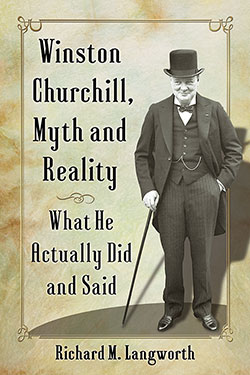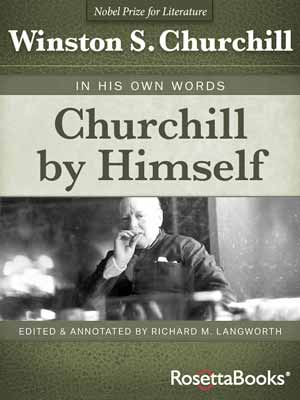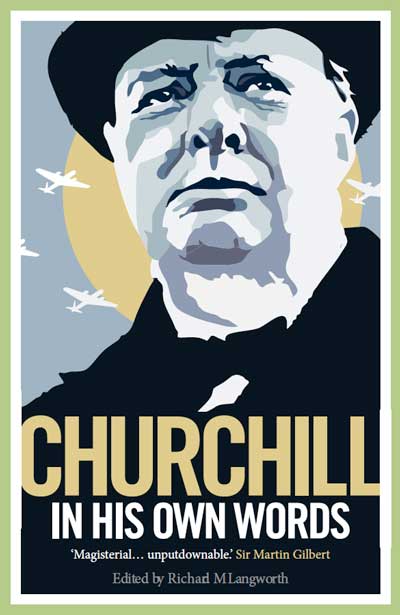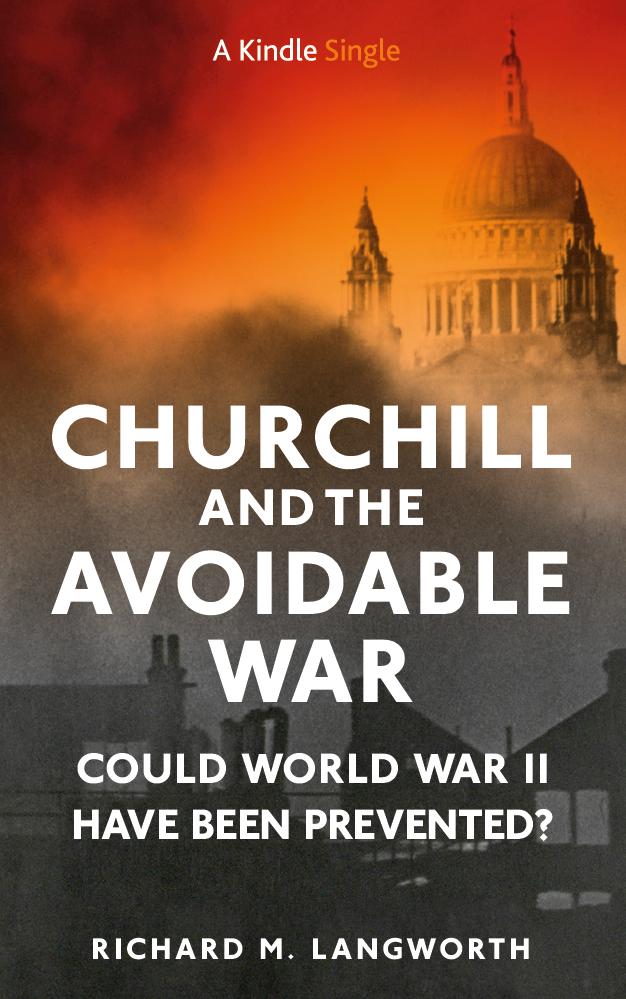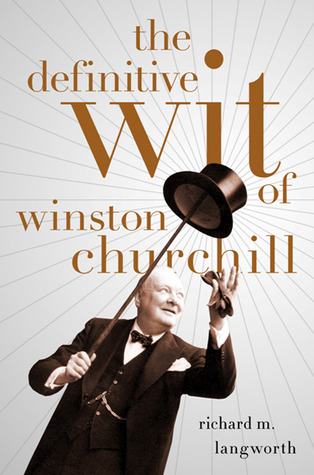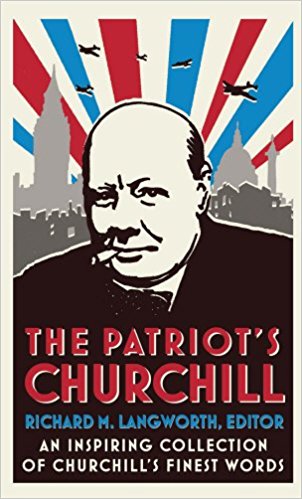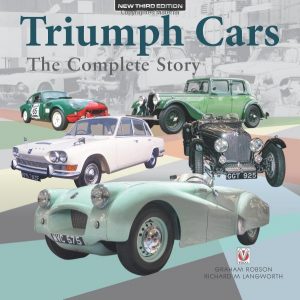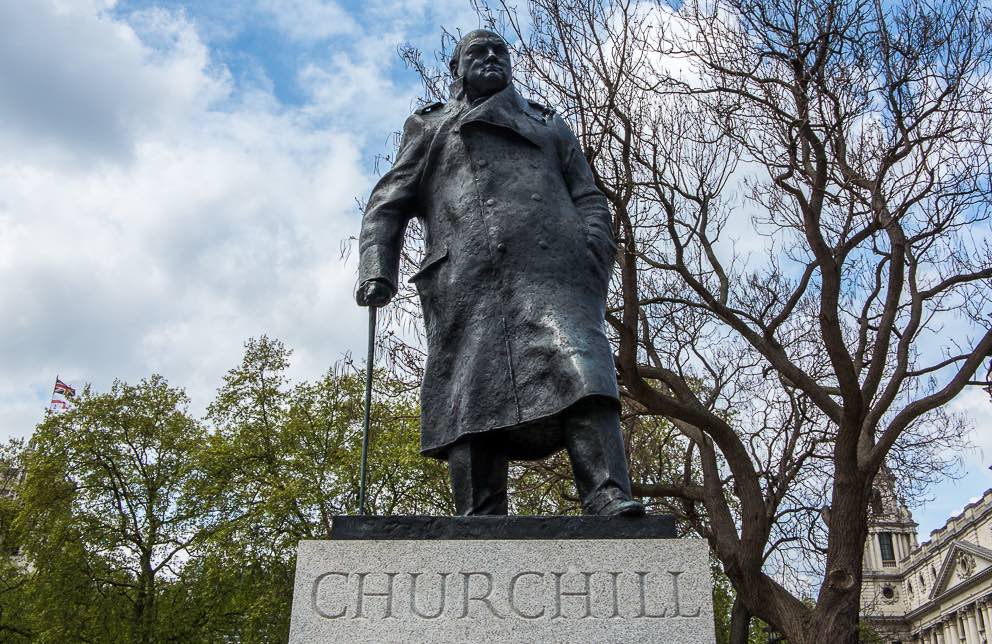
Interview: Some Thoughts on Churchill’s London Statue
“Everything should be presented decorously to future generations. Litter should not be allowed to gather around the monument upon which only the good and great things that men have done should be inscribed.” —Winston S. Churchill, “Clemenceau,” in Great Contemporaries (1937).
***
A British historian contacted three Churchill authors–Amthony Seldon, Andrew Roberts and me–about Ivor Roberts-Jones’s Churchill statue in Parliament Square. It features in a forthcoming book on 100 famous UK monuments. “Is it true that Churchill personally selected the site?”
We all expressed our doubts, despite one contrary piece of evidence. Philip Howard, in The Times of 2 November 1973, reported after the unveiling of the statue:
In the 1950s, David Eccles, then Minister of Works, showed Churchill plans for the redevelopment of Parliament Square. Churchill drew a circle in the north-east corner and declared: “That is where my statue will go.”
We were not sure this is dispositive. Told a statue was planned, WSC might have casually proposed its place. But he was not particularly avid about statuary. Once, asked if he’d like one in London, he said he would much prefer his name on a park that East End children could play in. Seventy years later, we are still waiting for the park.
Asked for more comment, I responded to questions, which may be of passing interest. The new book—which I think is a grand idea—focuses on war commemorations. It is not about the recent culture wars, in which the London statue has been variously defaced by ignorant people who haven’t read enough history.
The commemorative function of statues is appropriate, given the ignorance that surrounds them. The advent of social media combines anonymity with the ability to reach millions with one injudicious click. On this and the Hillsdale Churchill website, we notice that 90% of our cogent, polite reader comments are signed by real people, while the vulgar or nasty ones are unsigned, except by pseudonyms. One American pundit who accepts replies always says: “Name and town if you wish to opine.”
Questions and answers
Are you British or American, and what inspired your professional and personal interest in Churchill?
American, born in Rye, New York with three immigrant grandparents, German, Italian and a smidge of Latvian. My interest began while watching the 1965 State Funeral on a flickering B&W telly. Having studied history, it occurred that this was somebody I should learn more about. I picked up The Gathering Storm, Churchill’s first volume of war memoirs, and was hooked. Above everything else he did, what a superlative writer! He is a model to scribblers. We follow meekly in his wake.
What is the perception of Churchill in America is today? Do most young people know who he is? Recently a U.S. conspiracy theorist went viral with a denigration of Churchill. Was this proof of WSC’s ongoing relevance?
Historically, he will always be relevant. Yet a recent survey suggested that some appalling percentage of British schoolchildren think he was a fictional character. I fear the figure would be higher among Americans. History isn’t taught as it should be any more, which is why we need books on monuments, like yours.
Among those who know who Churchill was, impressions remain overwhelmingly positive, but shallow. It’s mostly the Second World War: blood, toil, tears and sweat. That includes, sadly, most politicians who profess to admire him. While books about him continue to pour off the presses, nowadays they tend to be either highly specialized (Mr. Churchill in the White House) or some off-the-wall demolition job, like Churchill’s Secret War.
The leader and the man
I am struck that you historians were all surprised by the idea that Churchill might have self-selected his spot in Parliament Square. Is there a danger that his subsequent popularity in the late Twentieth Century (when we started obsessively to commemorate the war) distorted our idea of him as person and leader? How would you sum up the leader and the man?
All three of us knew that he was not big on totems, though like anyone who has done great things, not averse to them! His wish for a park instead of a statue is I think more revealing than his spontaneous mark on a development plan.
You are quite right—our obsession with the war (and the many misinterpretations of it) has distorted his record. When asked to summarize him, I always quote Sir Martin Gilbert, who described Churchill in one sentence:
“He was a great humanitarian who was himself distressed that the accidents of history gave him his greatest power at a time when everything had to be focused on defending the country from destruction, rather than achieving his goals of a fairer society.”
“Liberty itself”
For a little more detail, consider Sir Martin’s last words in the Official Biography:
Churchill was indeed a noble spirit, sustained in his long life by a faith in the capacity of man to live in peace, to seek prosperity, and to ward off threats and dangers by his own exertions. His love of country, his sense of fair play, his hopes for the human race, were matched by formidable powers of work and thought, vision and foresight. His path had often been dogged by controversy, disappointment and abuse, but these had never deflected him from his sense of duty and his faith in the British people….
From his daughter Mary had come words of solace…when at last his life’s great impulses were fading. “In addition to all the feelings a daughter has for a loving, generous father,’ she wrote, ‘I owe you what every Englishman, woman and child does—Liberty itself.”
The London statue
Do you think the statue captures the essence of Churchill? Standing in his greatcoat, at what stage in his life does the statue depict? Is Britain still at war?
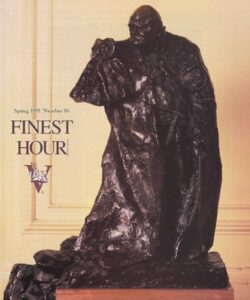
It is not widely known that the existing statue was not the first proposal. Back in 1995, as editor of Finest Hour, I ran a cover photo of Roberts-Jones’s first bronze maquette, in Garter robes, which had come up for sale. It had actually been approved by the Royal Fine Arts Commission when Lady Churchill asked that the statue be in military uniform. Her daughter Lady Soames confirmed this to me. The greatcoat is perfect—not redolent of any one branch of the military.
Of course Lady Churchill was right. As her husband said, “Nothing surpasses 1940.” His grandson Winston thought, with some justification, that his warnings of the late 1930s were his true finest hours. But Lady Churchill knew he had to appear as the great wartime figure.
I think Ivor Roberts-Jones gave him the perfect expression as he gazes at Parliament. In his eerie short story, The Dream, about conversing with the ghost of his father, Lord Randolph mentions the House of Commons. His son wrote: “There was a sort of glare in his eyes as he said ‘House of Commons.’” (You can read this marvelous flight of fancy on the Hillsdale College Churchill Project website.)
“To err on the side of history’s defaulters”
How important are statues like Churchill’s in terms of telling a nation’s story? We also have one of de Gaulle in London, Churchill’s nemesis in many ways (after which Paris erected one of Churchill!)
Ah, Le Grand Charles. Brendan Bracken said, “Remember, Winston…he thinks of himself as the reincarnation of St. Joan.” WSC replied, “Yes, but my bishops won’t burn him!”
Yet in the end each of these two imposing figures respected and honored the other. De Gaulle gave Churchill the Ordre de la Libération, and attended his funeral. In a message to his widow, de Gaulle wrote: “In the great drama, he was the greatest.” And Churchill in his war memoirs called de Gaulle “the Constable of France.”
This is a quality we seem to be losing: “To err on the side of history’s defaulters,” in the words of the great Allen Guelzo. Heroes are what they are because the good they did far outweighs their faults. All those statues on Parliament Square are of people with human faults. Gandhi fought for Indian rights in South Africa but thought blacks “live like animals” and wanted whites to stay in charge. And yet, he was Gandhi—and on balance, a hero.
During the craze to tear down statues a few years ago, French President Macron boldly announced that no French statues would go. They are part of France’s heritage, he said—for good or ill. That was very courageous of him. Statues tell a nation’s story. If you object to one, erect one to balance it. Hillsdale College has no statue of Robert E. Lee—but we do have one of Frederick Douglass. There is no hiding from history.
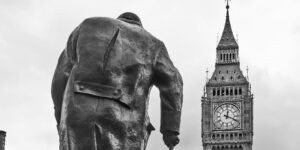
“Eels get used to skinning…”
It is impossible to know, but what do you imagine Churchill’s response would be to acquiring a grass Mohican, red paint, etc.? Could one argue that iconoclasm is a sign of true national greatness? Would he see it like that?
His daughter impressed me with what I call The Mary Soames Commandment: “Thou shalt not proclaim what Papa would say about any modern issue. After all, how do you know?”
So we cannot say. Still, he did love critical caricatures of him, even bought and framed some. In his 1931 essay “Cartoons and Cartoonists” he wrote:
Just as eels are supposed to get used to skinning, so politicians get used to being caricatured.…If we must confess it, they are quite offended and downcast when the cartoons stop.… They fear old age and obsolescence are creeping upon them. They murmur: “We are not mauled and maltreated as we used to be. The great days are ended.”
Related reading
“Allen Guelzo on Robert E. Lee: ‘To Err on the Side of History’s Defaulters,'” 2021.
“‘Since Thomas Jefferson Dined Alone’…JFK, Winston Churchill,” 2023.
“Foreword to a Review of ‘The Racial Consquences of Mr. Churchill,'” 2021
“In Defense of Churchill: Questions and Answers,” 2021.
“Churchill’s Legacy Today: Undented in the Digital Age,” 2023.
